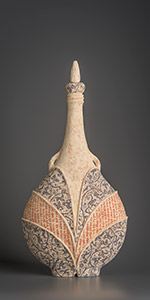
“There exists a universal artistic lineage which touches a place that is beyond time,” says the now internationally acclaimed ceramic artist. “I search for clues in the relics that history has left behind, in the marks of individuality within the collective.”
“There is also the question of what role does an object play in our lives? The integration of notions of utility, aesthetics and divinity in vessel-form is as ancient as conscious existence,” continues Sheffer. “I perceive material and spirit as inseparable.”
The vessels in Sheffer’s current body of work are on a slightly smaller, more intimate scale and the surface treatments display greater intricacy. “Like all things, the nature of the vessel evolves over time,” she offers. The cross-cultural traditions Sheffer observed during holidays in Cuba have had an influence on certain works. She was particularly intrigued with the ubiquitous use of hand fans in that country. Apart from being an obvious cooling device, the position in which a fan is held can communicate a secret language. The curvilinear demarcations on the Abanico (Sp. hand fan) vessels reference this fascination, although the calligraphic features contained therein are of Levantine origin. The flame-like stoppers are simultaneously points of closure and continuations of form to suggest movement.
Supremely elegant, the Chalcos vessels take their name from the prehistoric Copper Age – a time characterised by an unprecedented acceleration in cultural development. Stepped appliquéd bands billow across the forms. “These represent the steps between layers of history and consciousness,” explains Sheffer. “They also emulate how the body wraps or drapes itself in fabrics.” The Kevara pieces resonate a Moorish influence, especially in the intricate latticework of the handles which recalls reticulated windows streaming patterned light.
A prodigious technical process is required to actualise Sheffer’s quest to create vessels that evince the archetypal and meld dichotomies. “Initially, I am searching for lines of form and afterwards, the enhancement of that silhouette,” she explains. Each of her hand-built vessels evolves intuitively from a base of coiled clay and when the form is resolved attention is focused on the surface of the raw clay. “I perceive it as the deep skin of the work – one that is aged, scarred and perforated. Engobes and dry glazes are then applied and the piece is fired several times until the surface is rich and ripe to receive the print-work designs that will follow,” furthers Sheffer. “The business of printing is risky and unforgiving. I must move from working spontaneously and being in my body into a more intellectual and considered process.” Her visual library houses a vast body of diverse ancient texts and decorative elements. Chosen to compliment the form rather than for any instructive purpose, the scripts Sheffer selects are silk-screened onto paper transfer that is then conveyed to the vessel’s surface before a final firing. The result is a weathered quality that exudes a sense of having been unearthed from a primeval resting place.
Sheffer has been a member of the International Academy of Ceramics since 2009. As of 2004 she has held twenty-six solo exhibitions in Australia, USA and the UK, including a touring show to Regional Galleries across Australia. Her work has been presented at Collect, Art London; SOFA New York & Chicago; she was Artist In Residence at the Israel Museum, Archeology Wing, Jerusalem 2011. Sheffer has participated in numerous invitational group exhibitions and has been a presenter and demonstrator at several International Conferences. A finalist in many competitions including the Blake Prize 2011, she won The Border Art Prize 2008 and the Josephine Ulrick Award for Excellence, Gold Coast International Ceramic Award 2005. In 2006 and 2008 she received Australia Council Grants for new work and was recently awarded the Australia Council Artist Residency in the Barcelona Studio for 2016.
Her ceramic vessels are represented in the selected collections: National Gallery of Australia, Canberra; Powerhouse Museum, Sydney; Jewish Museum of Australia; Artelier d’Art de France, Paris; Manly Art Gallery; Bendigo Art Gallery; Art Gallery of Ballarat; Southern Downs Regional Art Collection, Stanthorpe; Gold Coast City Gallery; Shepparton Art Gallery; Glasshouse Regional Gallery, Port Macquarie; Tweed River Regional Gallery; Grafton Regional Gallery; Ceramics Victoria Permanent Collection; Brisbane Grammar School Art Collection; Russell Berrie Foundation, USA; Charles Bronfman Collection, USA.
Receive e-mail updates on our exhibitions, events and more
Subscribe Now